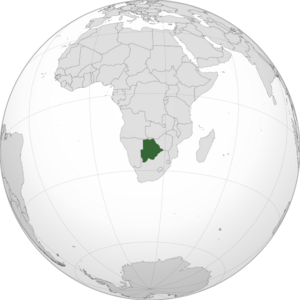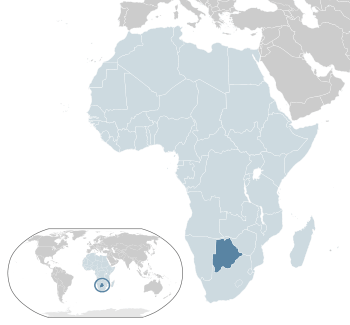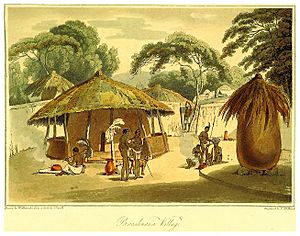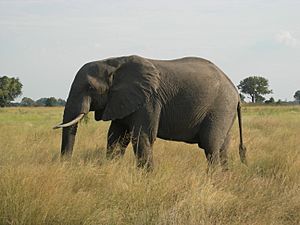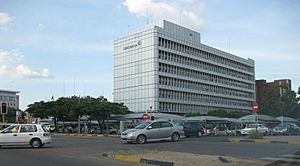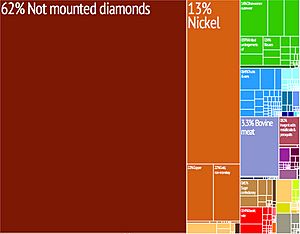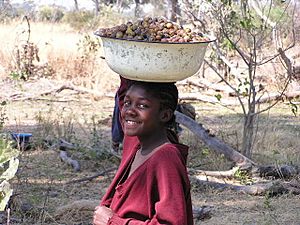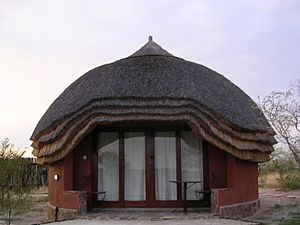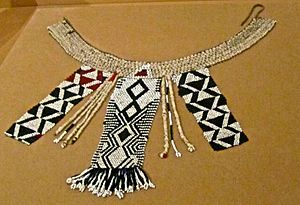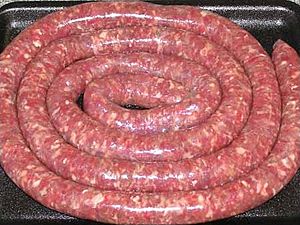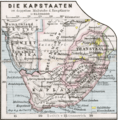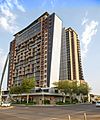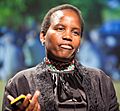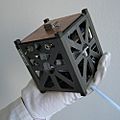Botswana facts for kids
Quick facts for kids
Republic of Botswana
Lefatshe la Botswana (Tswana)
|
|
|---|---|
|
|
|
|
Motto: Pula
"Let it Rain" |
|
|
Anthem: Fatshe leno la rona
"Blessed Be This Noble Land" |
|
| Capital and largest city
|
Gaborone 24°39.5′S 25°54.5′E / 24.6583°S 25.9083°E |
| Official languages | English |
| National language | Setswana |
| Ethnic groups
(2024)
|
|
| Religion
(2021)
|
|
| Demonym(s) |
|
| Government | Unitary dominant-party parliamentary republic with an executive presidency |
| Duma Boko | |
|
• National Assembly Speaker
|
Phandu Skelemani |
| Legislature | Parliament (National Assembly) |
| Independence
from the United Kingdom
|
|
|
• Established (Constitution)
|
30 September 1966 |
| Area | |
|
• Total
|
581,730 km2 (224,610 sq mi) (47th) |
|
• Water (%)
|
2.7 |
| Population | |
|
• 2023 estimate
|
2,417,596 (145th) |
|
• 2022 census
|
2,359,609 |
|
• Density
|
4.1/km2 (10.6/sq mi) (231st) |
| GDP (PPP) | 2024 estimate |
|
• Total
|
|
|
• Per capita
|
|
| GDP (nominal) | 2024 estimate |
|
• Total
|
|
|
• Per capita
|
|
| Gini (2016) | ▼ 45.5 medium |
| HDI (2022) | high · 114th |
| Currency | Pula (BWP) |
| Time zone | UTC+2 (Central Africa Time) |
| Date format | dd/mm/yyyy |
| Driving side | left |
| Calling code | +267 |
| ISO 3166 code | BW |
| Internet TLD | .bw |
Botswana, officially called the Republic of Botswana, is a country located in southern Africa. The capital of Botswana is Gaborone.
Contents
History of Botswana
Early People in Botswana

The story of Botswana began over 100,000 years ago. This is when the first humans lived in the area. The very first people in southern Africa were the San and Khoi groups. They spoke Khoisan languages and lived by hunting and gathering.
About a thousand years ago, large groups of people formed. These groups were later part of the Great Zimbabwe empire. This empire reached into eastern Botswana.
Around 1300 CE, people in what is now Transvaal started to form three main groups. One of these groups was the Batswana. The Batswana are the main ethnic group in Botswana today. Before Europeans arrived, the Batswana were herders and farmers. They lived under tribal rule.
Europeans Arrive in Botswana
In the 1700s, the slave and ivory trades grew. To fight against these pressures, Shaka, the king of the Zulu Empire, built a strong army. Tribes that were conquered moved northwest into Botswana. They destroyed things as they went.
Later, tribes started trading ivory and animal skins for guns. They traded with European traders who had reached the interior. Christian missionaries also came from Europe. Tribal chiefs often invited them. This was because missionaries encouraged traders to come. By 1880, most major villages had a missionary. Their influence became lasting. Christianization was completed in Botswana under King Khama III. There were eight main tribes. The Bangwaketse tribe was the most powerful.
In the late 1800s, fighting broke out. This was between the Tswana people of Botswana and Ndebele tribes. The Ndebele were moving into the area from the northeast. There were also problems with Dutch Boer settlers from the Transvaal to the east.
Tswana leaders like Khama III, Bathoen, and Sebele asked for help. The British Government then took Botswana under its protection on March 31, 1885. The northern part became the Bechuanaland Protectorate. This area later became modern-day Botswana. The southern part became part of the Cape Colony. It is now part of South Africa. Most Setswana-speaking people live in South Africa today.

In 1910, the Union of South Africa was formed. It included the main British colonies in the region. But the Bechuanaland Protectorate, Basutoland (now Lesotho), and Swaziland were not included. There was a plan for them to join later. However, the UK started asking the people what they wanted.
South African governments wanted these areas to join them. But the UK kept delaying. So, it never happened. In 1948, a new government in South Africa introduced apartheid. This was a system of unfair laws. Also, South Africa left the Commonwealth of Nations in 1961. These events meant Botswana would not join South Africa.
The British government expanded its power. Tribal governments also changed. In 1920, two advisory councils were set up. They represented both Africans and Europeans. The African Council had eight tribal chiefs and some elected members. New rules in 1934 controlled tribal power. In 1951, a European-African advisory council was formed. A new constitution in 1961 created a legislative council.
Botswana Gains Independence
In June 1964, the United Kingdom agreed to allow Botswana to govern itself. In 1965, the government moved from Mafikeng in South Africa. It moved to the new city of Gaborone, which is near Botswana's border with South Africa.
Based on the 1965 constitution, Botswana held its first general elections. Everyone could vote. The country became independent on September 30, 1966. Seretse Khama was a leader in the independence movement. He was elected as the first President. He was re-elected two more times.
After Seretse Khama, Quett Masire became President. He was elected in 1984, 1989, and 1994. Masire retired in 1998. Festus Mogae took over. He was elected in 1999 and 2004. In 2008, Ian Khama became President. He is the son of the first President.
There was a long disagreement about the northern border with Namibia's Caprivi Strip. The International Court of Justice made a decision in December 1999. It said that Kasikili Island belongs to Botswana.
Geography of Botswana
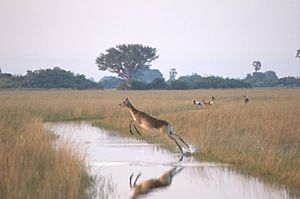
Botswana is about 581,730 square kilometers (224,610 sq mi) in size. This makes it the world's 48th-largest country. It is similar in size to Madagascar or France. It is located between 17° and 27°S latitude, and 20° and 30°E longitude.
The country is mostly flat. It has gently rolling tablelands. The Kalahari Desert covers about 70% of Botswana's land. In the northwest is the Okavango Delta. It is one of the world's largest inland deltas. The Makgadikgadi Pan, a large salt pan, is in the north.
The Limpopo River Basin is a major landform in southern Africa. Part of it is in Botswana. Its smaller rivers, like the Notwane and Shashe, are in the eastern part of the country. The Notwane River provides water to the capital city, Gaborone. The Chobe River is in the north. It forms a border between Botswana and Namibia. The Chobe River meets the Zambezi River at a place called Kazungula.
Wildlife and Nature
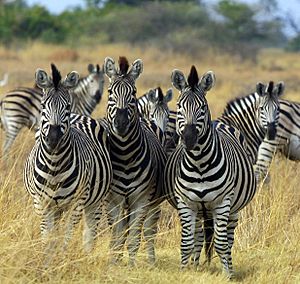
Botswana has many different types of wildlife habitats. Besides the delta and desert, there are grasslands and savannas. Here you can find blue wildebeest, antelopes, and many other mammals and birds. Northern Botswana has one of the largest groups of the endangered African wild dog.
Chobe National Park has the world's largest number of African elephants. The park is about 11,000 square kilometers (4,200 sq mi). It is home to about 350 kinds of birds.
Chobe National Park and Moremi Game Reserve (in the Okavango Delta) are popular places for tourists. Other reserves include the Central Kalahari Game Reserve. This is in the Kalahari desert. The Makgadikgadi Pans National Park and Nxai Pan National Park are also important. Mashatu Game Reserve is privately owned. It is where the Shashe River and Limpopo River meet. The Mokolodi Nature Reserve is near Gaborone. There are also special places like the Khama Rhino Sanctuary for rhinoceros and Makgadikgadi Sanctuary for flamingos.
Botswana's Economy
Since becoming independent, Botswana has grown very quickly. It has gone from being one of the poorest countries to a middle-income country. Botswana has many natural resources. It used a good system to invest money from these resources. This helped create steady income for the future. Botswana has one of the highest incomes per person in Africa. This means people have a good standard of living.
Botswana buys refined oil products and electricity from South Africa. It also produces some electricity from coal within the country.
Diamonds and Other Minerals
The Department of Mines in Gaborone keeps track of mining in Botswana. Debswana is the biggest diamond mining company in Botswana. The government owns half of it. The mining industry provides about 40% of all government money.
In 2007, a lot of uranium was found. Mining was expected to start by 2010. Many international mining companies have set up offices in Botswana. They look for diamonds, gold, uranium, copper, and even oil. Many have found good results. In early 2009, the government said it would try to rely less on diamonds. This is because diamonds are expected to run out in Botswana in the next twenty years.
Botswana's Orapa mine is the largest diamond mine in the world. It produces the most diamonds by value and quantity each year. In 2013, it produced over 11 million carats. This was worth over $1.6 billion.
People of Botswana
The Tswana are the largest ethnic group in Botswana. They make up 79% of the population. The biggest minority groups are the BaKalanga and San (also called Basarwa). Other tribes include Bayei, Bambukushu, Basubia, Baherero, and Bakgalagadi.
There are also small numbers of white people and Indians. Botswana's Indian population includes many Indian-Africans who have lived there for generations. Some came from Mozambique, Kenya, Tanzania, Mauritius, and South Africa. There are also new Indian immigrants. The white population speaks English and Afrikaans. They make up about 3% of the population.
Since 2000, many people from Zimbabwe have moved to Botswana. This is because of economic problems in Zimbabwe.
Fewer than 10,000 San people still live their traditional hunter-gatherer way of life.
Languages Spoken
The official language of Botswana is English. However, Setswana is spoken widely across the country. In Setswana, prefixes are very important. They show different groups of nouns. For example, Bo refers to the country. Ba refers to the people. Mo is one person. Se is the language. So, the main group of people is the Tswana. The country is Botswana. The people are Batswana. One person is a Motswana. The language they speak is Setswana.
Other languages spoken in Botswana include Kalanga, Sarwa, Ndebele, !Xóõ, and Afrikaans.
Religion in Botswana
About 70% of people in Botswana are Christians. Most Christians are Anglicans, Methodists, and members of the United Congregational Church of Southern Africa. There are also Lutherans, Baptists, Roman Catholics, Mormons, and others. In Gaborone, there is a Lutheran History Centre that people can visit.
According to the 2001 census, there are about 5,000 Muslims. Most of them are from South Asia. There are also 3,000 Hindus and 700 Baha'is. About 20% of people do not follow any religion. Religious services are well attended in both cities and rural areas.
Culture of Botswana
Setswana describes the rich cultural traditions of the Batswana people. This includes both the Tswana ethnic groups and all citizens of Botswana. In Botswana, most tribes have different ways to greet each other. But for easy communication, Batswana use a three-way handshake. Or, one can just say "Dumelang" to say "hello."
During community celebrations like Dikgafela or marriage ceremonies, Batswana women show excitement. They use ululations as part of their culture.
Music in Botswana
Botswana music is mostly singing. It is sometimes performed without drums. It also uses many string instruments. Traditional instruments include the Setinkane (a small piano) and Segankure/Segaba (like a Chinese Erhu). Moropa (drums) and phala (a whistle) are also used. Hands are also used as instruments. People clap them together or against phathisi (goat skin wrapped around the calf, used by men).
In recent decades, the guitar has become very popular for Tswana music. It offers more variety than the Segaba. Dancing is a highlight of any celebration. Dances differ by age, gender, and status. The national anthem is Fatshe leno la rona. It was written and composed by Kgalemang Tumediso Motsete. It was adopted when Botswana became independent in 1966.
Art in Botswana
In northern Botswana, women in the villages of Etsha and Gumare are known for making baskets. They use Mokola Palm and local dyes. The baskets come in three main types:
- Large, lidded baskets for storage.
- Large, open baskets for carrying things on the head or for separating grain.
- Smaller plates for separating pounded grain.
The art of these baskets is getting better with more colors and designs. This is because they are sold to people around the world.
Other famous art communities include Thamaga Pottery and Oodi Weavers. Both are in southeastern Botswana.
The oldest paintings in Botswana and South Africa show hunting, animals, and people. They were made by the Khoisan (!Kung San/Bushmen) over twenty thousand years ago. These paintings are found in the Kalahari Desert.
Food in Botswana
Botswana's food is special. But it also shares some things with other southern African foods. Examples of Botswana food are pap (maize porridge), boerewors, samp, vetkoek (fried dough bread), and mopani worms. A unique food in Botswana is seswaa. This is heavily salted mashed-up meat.
Related pages
Images for kids
-
The 'Two Rhino' painting at Tsodilo, a UNESCO World Heritage Site
-
Unity Dow, author of Far and Beyon', The Screaming of the Innocent and Heavens May Fall
See also
 In Spanish: Botsuana para niños
In Spanish: Botsuana para niños




